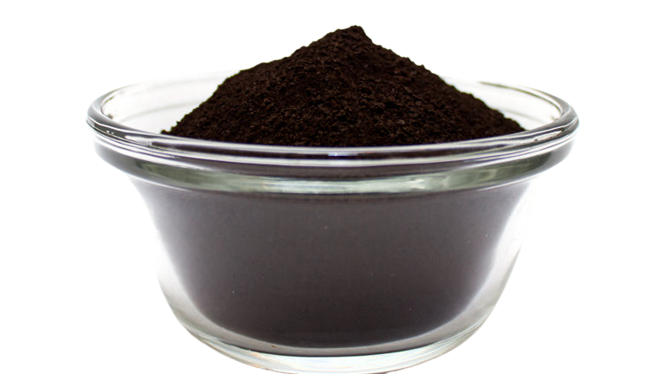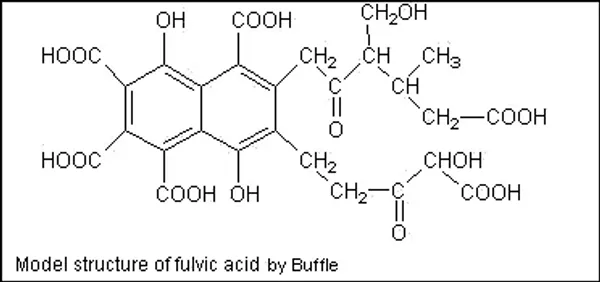It has a high molecular weight and larger molecule size and it is not soluble under acidic conditions. With a high molecular weight and insoluble, humic does not penetrate the cell membrane and therefore protects the outer cell walls from invasion of harmful toxins, oxidants, microbes and viruses where bacteria, fungus and yeast can thrive.
Humic has one of the highest fibre content known to man, hydrating the body and highly active in carbon. These larger molecules are not easily absorbed by the body, so they remain in our digestive tracts benefiting us in other ways. Humic molecules act as prebiotic fibres feeding our beneficial bacteria and helping to keep our gut microbiome balanced.

The molecules also excel at capturing toxins before our bodies can absorb them. Humic is important for vitamin D synthesis, production of melanin and protection of RNA and DNA. It also has a high Carbon content but low in Oxygen, therefore it works on the outside of the cells, by removing toxins before they even enter the cell allowing the immune system to function at peak performance, attacking toxins, defending against allergens, germs, bacteria and other hazards.
Fulvic works inside the cell, Humic works outside the cell. Together they work in complete synergy and harmony creating and extremely potent full spectrum tonic for the entire body system which we call ''Phyto-Minerals''. Containing 60% Humic content.



Fulvic acid has been discovered to be one of the most important natural miracles related to life itself. An acid created in extremely small amount by the action of millions of beneficial microbes working on decaying plant matter in a soil environment with high Oxygen levels.
Fulvic has a low molecular weight and small molecular size and is highly soluble, it also has a high Oxygen content but is low in Carbon, therefore it is biologically very active and has the ability to penetrate the cell and mitochondria wall, passing through the blood brain barrier.

Because of this it has the ability to work inside the cell, correcting abnormalities, boost cellular energy and assist in peak cellular function, carrying up to sixty times its molecular weight in nutrition, facilitating in the transport of larger quantities of nutrients and dissolving the nutrients within our food and carrying them to the cells. Fulvic also strengthens cell membranes, cleaning toxins and waste material within the cell and carries it out of the system.
One molecule of fulvic acid can donate fourteen tera-trillion electrons. That’s twenty-one zeros! It has the unique ability to react with both negatively and positively charged unpaired electrons, rendering free radicals harmless. It then alters the mineral to new useable compounds or eliminates them as waste. Phyto-minerals and Fulvika products contain 40% Fulvic content.


Common Virus Shows Link To Brain Cancer In Children
Colon, penile, uterine, cervical, liver, and numerous other cancers are also caused by viruses
A new study appearing today in the Journal of the National Cancer Institute, shows that the JC Virus (JCV) which infects about 65% of children by age 14, likely plays a role in the development of the most common type of malignant brain tumor found in children. This finding is consistent with many other recent reports linking viruses to cancer.
The JC Virus is named after a patient, John Cunningham, from whom the virus was first isolated in the 1970’s. According to the senior author of the study, Dr. Kamel Khalili, the JC Virus “is very common,” and he went on to say that “sixty-five to 70 percent of human populations worldwide get infected with this virus by age 14, so we all basically have this virus in our bodies.”
Twenty specimens of brain tumors taken from children showed evidence of the JC Virus. Dr. Khalili says that “the presence of the virus… is suggestive of a biological role for this virus in the development of these tumors.” Khalili, who is a cancer researcher at Philadelphia’s Temple University, said that earlier lab studies show that the JC Virus causes cancer in rats, mice, and brain tumors in certain monkeys.
The JC virus comes from a viral group called Neutropic Polyomaviruses. It usually infects the upper respiratory system by inhalation of airborne particles just like the common cold. Polyomavirus caused respiratory infections are very common in children.
The virus causes no serious disease unless a person’s immune system is weak. In patients with very weak or destroyed immune systems (such as AIDS patients, or those who are taking organ anti-rejection drugs), according to Dr. Khalili, the JC Virus can cause progressive Multifocal Leukoenchephalopathy (PML), a fatal brain disease.
Dr. Khalili says that evidence suggests that JC Virus also plays a role in the development of the most common brain cancer in children, medulloblastoma. This type of cancer is diagnosed annually in about one out of every 200,000 children under the age of 15. It is a very aggressive cancer that is difficult to treat and often is fatal. Dr. Khalili says that if it can be conclusively proven that JC virus does play role in the brain cancer, then it may be possible to develop a vaccine that could help in treating the tumor or preventing its spread.
Studies by Dr. L. Laghi and associates have shown that JC Polyoma Virus also causes colon cancer. In other extensive research Dr. Richard C. Hunt, at the University of South Carolina, has documented many other viruses as the cause for colon, penile, uterine, cervical, liver, and numerous other cancers.
This information provides support for the idea that humic substances (fulvic acids) are a little-known and important missing link throughout the food chain.
Modern agricultural practices have eliminated the humic substances from farm soil, which parallels increases in viral plant, animal, and human viral infections. Common to rich organic soil humus, fulvic acids have been shown to have unequalled value in defending plants, animals, and man against viruses of all kinds, and also in significantly increasing and balancing immunity. Of interest is also the fact that hospital studies in China showed that children with serious respiratory infections responded exceptionally well to humic – fulvic extracts when nothing else seemed to work.
https://www.ncbi.nlm.nih.gov/pmc/articles/PMC6643347/
R. Ansorg, et al; Studies on the Antimicrobial Effect of Natural and Synthetic Humic Acids; Arzeimittelforschung 1978, 28(12), pp. 2195-2198.
Treatment of HIV Infection with Humic Acid; WO95/08335 – PCT; Mar. 30, 1995.
K.D. Thiel; et al; Comparison of the in Vitro Activities of Ammonium Humate and of Enzymically Oxidized Chlorogenic and Caffeic Acids Against Type 1 and Type 2 Human Herpes Virus; Pharmazie 1981, 36(1), pp. 50-53.
H. Schultz; Investigations on the Viricidal Effects of Humic Acids in Peat-Mull; Dtsch Tierarztl Wochenschr Jul. 1, 1965. 72(13), pp. 294-297.
R. Klocking, et al; Antiviral Properties of Humic Acids; Experientia May 15, 1972, 28(5), pp. 607-608.
G. Sydow, et al; The Effect of Phenolic Polymers on Retroviruses; Pharmazie Dec. 1986, 41(12), pp. 865-868.
R. Klocking and M. Sprossig; Experientia 1972 28(5)–pp. 607-608.
R. Klocking, et al; Antiviral Activity of Phenolic Polymers Against Type 1 Herpesvirus Hominis; Pharmazie Aug. 1978, 33(8), p. 539.
F. Schiller, et al; Results of an Oriented Clinical Trial of Ammonium Humate for the Local Treatment of Herpesvirus Hominus (HVH) Infections; Dermatol Monatsschr Jul. 1979, 165(7), pp. 505-509.
R. Klocking; Interaction of Humic Acids and Humic-Acid-Like Polymers with Herpes Simplex Virus Type 1; Humanic Substances in the Aquatic and Terrestrial Environment, Berlin 1991, pp. 408-412.
K.D. Thiel, et al; In Vitro Studies of the Antiviral Activity of Ammonium Humate Against Herpes Simplex Virus Type 1 and Type 2; Zentralbl Bakteriol (Orig. A) Nov. 1977, 239(3), pp.
304-321.
J. Schneider, et al; Inhibition of HIV-1 in Cell Culture by Synthetic Humate Analogues Derived From Hydroquinone: Mechanism of Inhibition; Virology 1996, 218(2), pp. 389-395.
R. Mentel, et al; Effectiveness of Phenol Body Polymers Against Influenza Virus A/KRASNODAR/101/59/H2N2; Biomed Biochim Acta 1983, 42(10), pp. 1353-1356.
J. Hills; et al; Inhibition of Several Strains of Influenza Virus Type A and B by Phenolic Polymers; Biomed Biochim Acta 1986, 45(9), pp. 1173-1179.
K.I. Hanninen, et al; Synthesis and Characterization of Humic Acid-Like Polymers; The Science of the Total Environment 1987, 62, pp. 201-210.
R. Klocking et al.–Interaction of Humic Acids and Humic-Acid-Like Polymers with Herpes Simplex Virus Type 1 Humic Substances in the Aquatic and Terrestrial Environment New York; Springer-Verlag 1989, pp. 407-412.
D. Schols, et al; Selective Inhibitory Activity of Polyhydroxycarboxylates Derived From Phenolic Compounds
Against Human Immunodeficiency Virus Replication; Journal of Acquired Immune Deficiency Syndromes 1991, 4(7), pp. 677-685.
M. Cushman, et al; Synthesis and Anti-Hiv Activities of Low Molecular Weight Aurintricarboxylic Acid Fragments and Related Compounds; Journal of Medicinal Chemistry 1991, 34(1), pp. 337-342.
M. Robert Gero, et al; Biochemical Study of Humus Action of a Proteolytic Enzyme on Natural and Synthetic Humic Polymers and Those of Microbial Origin–Ann Inst Pasteur (Paris) Dec. 1967,
113(6), pp. 903-909.
M. Jakubiec; et al; Comparison of the Effect of Natural and Synthetic Humates and EDTA on the Growth of Escherichia coli; Abstract not available.
R. Ansorg; et al; Studies on the Antimicrobial Effect on Natural and Synthetic Humic Acids; Arzneimittleforschung 1978, 28(12, pp. 2195-2198.
M. Cushman, P. Wang, S. H. Chang, C. Wild, E. De Clercq, D. Schols, M. E. Goldman, and J. A. Bowen, J. Med. Chem. 1991, 34(1), 329-337
M. Cushman, S. Kanamathareddy, E. De Clercq, D. Schols, M. E. Goldman, and J. A. Bowen, J. Med. Chem. 1991, 34(1), 337-342
D. Schols, P. Wutzler, R. Klocking, B. Helbig, and E. De Clercq, J. Acquir. Immune Defic. Syndr. 1991, 4(7), 677-685
S. Loya, R. Tal, A. Hizi, S. Issacs, Y. Kashman, and Y. Loya, J. Nat. Prod. 1993, 56(12), 2120-2125
J. Schneider, R. Weis, C. Manner, B, Kary, A. Werner, B. J. Seubert, and U. N. Riede, Virology 1996, 218(2), 389-395
1. https://www.ncbi.nlm.nih.gov/pmc/articles/PMC6151376
2. https://www.ncbi.nlm.nih.gov/pubmed/21785188
3. https://www.ncbi.nlm.nih.gov/pmc/articles/PMC203572
4. https://www.ncbi.nlm.nih.gov/pubmed/2984989
5. https://www.ncbi.nlm.nih.gov/pubmed/25732236
6. https://www.ncbi.nlm.nih.gov/pubmed/28223733
7. https://www.ncbi.nlm.nih.gov/pubmed/8610466
8. https://www.ncbi.nlm.nih.gov/pubmed/11890523
9. https://www.ncbi.nlm.nih.gov/pubmed/17984596
10. https://www.ncbi.nlm.nih.gov/pubmed/22479260
11. https://www.ncbi.nlm.nih.gov/pmc/articles/PMC4691117
12. Impact of humic acids on the colonic microbiome in healthy volunteers (nih.gov)
13. (PDF) The Cytotoxic Effects of Humic Acid on Human Breast Cancer Cells (researchgate.net)

2190 Industrial Drive , RM of Sherwood , SK , S4K 0A6
info@naturalnutrirx.com
| Cookie | Duration | Description |
|---|---|---|
| cookielawinfo-checkbox-analytics | 11 months | This cookie is set by GDPR Cookie Consent plugin. The cookie is used to store the user consent for the cookies in the category "Analytics". |
| cookielawinfo-checkbox-functional | 11 months | The cookie is set by GDPR cookie consent to record the user consent for the cookies in the category "Functional". |
| cookielawinfo-checkbox-necessary | 11 months | This cookie is set by GDPR Cookie Consent plugin. The cookies is used to store the user consent for the cookies in the category "Necessary". |
| cookielawinfo-checkbox-others | 11 months | This cookie is set by GDPR Cookie Consent plugin. The cookie is used to store the user consent for the cookies in the category "Other. |
| cookielawinfo-checkbox-performance | 11 months | This cookie is set by GDPR Cookie Consent plugin. The cookie is used to store the user consent for the cookies in the category "Performance". |
| viewed_cookie_policy | 11 months | The cookie is set by the GDPR Cookie Consent plugin and is used to store whether or not user has consented to the use of cookies. It does not store any personal data. |